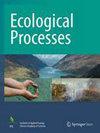温带林牧系统中因果关系的空间模式:从硝化稳定性应对洪水的角度看问题
IF 3.9
2区 环境科学与生态学
Q1 ECOLOGY
引用次数: 0
摘要
据预测,极端降雨和洪水事件会越来越频繁,并扰乱生物地球化学循环,如氮(N)循环。通过将树木和草结合起来,造林农林业有望在应对洪水时提高这一循环的稳定性。然而,人们对林牧系统中硝化作用对洪水的反应知之甚少。本研究的目的是评估硝化对洪水反应的稳定性,并确定在温带造林牧场中驱动硝化的主要因果关系。研究评估了两个林牧系统(即树篱和小巷种植)中相对于树木的三个位置的硝化稳定性(即抵抗力和恢复力)。分别在洪水胁迫四周后和胁迫结束四周后,在实验室测量了硝化潜力的抵抗力和恢复力。我们首次使用多组潜在结构方程模型(ML-SEM)来探索硝化稳定性与土壤特性之间的因果关系的空间结构。两个系统的树行都有利于抵抗硝化,而在淹水条件下,与草巷中两个评估位置的非压力土壤相比,平均硝化潜力分别高出 27% 和 35%。ML-SEM 发现,解释这些结果的因果关系在两个系统之间存在差异。所测试的 ML-SEM 模型无法解释绿篱系统中的因果关系。然而,考虑了土壤物理特性和土壤资源可用性之间协方差的模型(模型 A)能够解释胡同种植系统中的因果关系。研究表明,解释硝化稳定性的因果关系因相对于树木的位置而异:在树行中,硝化稳定性与较高的土壤有机碳浓度和蚯蚓数量有关;在草巷中,硝化稳定性与较高的土壤有机碳浓度和土壤容重有关。这项研究表明,林牧系统有助于调节树木附近的氮循环。研究结果进一步表明,土壤有机碳浓度和土壤容重的提高有利于调节草地中与氮有关的过程。本文章由计算机程序翻译,如有差异,请以英文原文为准。
Spatial patterns of causality in temperate silvopastoral systems: a perspective on nitrification stability in response to flooding
Extreme rainfall and flooding events are projected to increase in frequency and disturb biogeochemical cycles such as the nitrogen (N) cycle. By combining trees and grasses, silvopastoral agroforestry is expected to increase the stability of this cycle in response to flooding. However, little is known about the response of nitrification to flooding in silvopastoral systems. Aim of this study was to assess nitrification stability in response to flooding and identify the main causal relations that drive it in temperate silvopastures. The nitrification stability (i.e., resistance and resilience) was assessed in two silvopastoral systems (i.e., hedgerows and alley cropping) at three positions relative to the trees. The resistance and resilience of nitrification potential were measured in the laboratory after four weeks of flooding stress and four weeks after the end of the stress, respectively. For the first time, we used multigroup latent structural equation modeling (ML-SEM) to explore the spatial structure of causal relations between nitrification stability and soil properties across all positions of the two silvopastoral systems. Tree rows of both systems favored nitrification resistance, while the mean nitrification potential under flooded conditions was on average 27% and 35% higher as compared to non-stressed soils at the two positions assessed in the grass alleys. ML-SEM revealed that the causal relations that explained these results differed between the two systems. The ML-SEM models tested were unable to explain the causal relations in the hedgerow system. However, the model that considered a covariance between soil physical properties and soil resources availability (model A) was able to explain them in the alley-cropping system. It revealed that causal relations explaining nitrification stability varied according to the position relative to the trees: in the tree rows nitrification stability was associated with higher soil organic carbon concentration and earthworm abundance; in the grass alleys it was associated with higher soil organic carbon concentration and soil bulk density. This study indicates that silvopastoral systems help regulate the N cycle near the trees. The results further imply that improvements in soil organic carbon concentration and soil bulk density favor the regulation of N-related processes in grasslands.
求助全文
通过发布文献求助,成功后即可免费获取论文全文。
去求助
来源期刊

Ecological Processes
Environmental Science-Ecological Modeling
CiteScore
8.50
自引率
4.20%
发文量
64
审稿时长
13 weeks
期刊介绍:
Ecological Processes is an international, peer-reviewed, open access journal devoted to quality publications in ecological studies with a focus on the underlying processes responsible for the dynamics and functions of ecological systems at multiple spatial and temporal scales. The journal welcomes manuscripts on techniques, approaches, concepts, models, reviews, syntheses, short communications and applied research for advancing our knowledge and capability toward sustainability of ecosystems and the environment. Integrations of ecological and socio-economic processes are strongly encouraged.
 求助内容:
求助内容: 应助结果提醒方式:
应助结果提醒方式:


